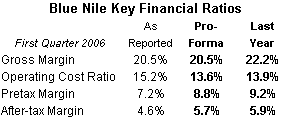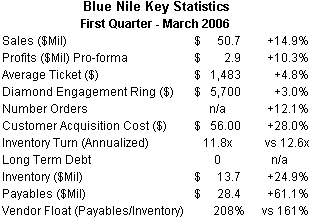IDEX Online Research: The Numbers Tell Us Blue Nile Is a Maturing Company
May 11, 06
Blue Nile reported slowing revenue gains and even slower profit growth for its first quarter ended March 2006. The question jewelers must ask is this: Is the bloom off the Internet rose?
The quick answer to our question is that Blue Nile is a maturing company. With $203 million in sales in 2005, it ranked as the ninth largest specialty jeweler in the U.S. At this level of revenues, it is simply not possible to continue to post huge gains quarter after quarter. In terms of aggregate jewelry Internet sales growth, it is also expected to slow from the prior years’ torrid pace. IDEX Online Research has projected that Internet jewelry sales growth will moderate to a range of +11-13 percent annually over the next five years.
|
|
Highlights of the company’s first quarter include the following:
- Blue Nile’s average ticket was $1,483, up 4.8 percent from the prior year. This is nearly five times as large as the typical specialty jeweler’s ticket of about $300.
- Total orders were up about 12.1 percent versus the first quarter of 2005.
- Blue Nile’s average ticket for an engagement ring was an estimated $5,700, up about 3 percent from last year’s first quarter. This is more than double the value of the typical diamond engagement ring – $2,750 – which the DTC says Americans spent in 2005.
- Blue Nile management noted that diamond demand in the U.S. was soft in the first quarter, particularly at the high end. While Blue Nile’s average ticket is higher than a typical mass market jeweler, it is well below many “high-end” jewelers. We believe that Blue Nile’s customer has cut back on upgraded diamond engagement rings and other discretionary purchases. Overall, however, engagement ring demand has not softened; more than 80 percent of all U.S. brides receive a diamond engagement ring.
- Blue Nile noted that while overall sales trends in the first quarter were soft, demand accelerated throughout the quarter, with March sales up 23 percent versus the same month a year ago.
- The cost to acquire a customer shot up to an estimated $56 from the prior year’s $44, a 28 percent increase. This is due to sharply rising online marketing costs, including very high costs for search keywords.
- Blue Nile adopted a strategy that many jewelers use when sales slow: it cut retail prices of diamonds. It is difficult to determine how much prices were reduced, but the company’s gross margin fell to 20.5 percent from 22.0 percent last year. The company began to reduce prices in mid-February, so the reported margin erosion includes just six weeks of the new price-based promotion.
- Based on the recent ineffectiveness of Blue Nile’s online marketing efforts, management made the decision to cut prices rather than to increase marketing spend. Currently, Blue Nile spends about 4 percent of sales on marketing. Management said that promoting to a 22 percent gross margin with a 6 percent marketing spend (an increased level of marketing) was likely to be less effective than promoting to a 20 percent gross margin with a 4 percent marketing spend. In short, incremental marketing spend simply would not have generated substantially increased sales.
- Despite selected price reductions, Blue Nile says its product mix is generally unchanged: just over 70 percent of its business is engagement rings.
- In 2006, Blue Nile is focusing on increasing its conversion rate – converting browsers to buyers. In part, a new enhanced website will help; further, sharp pricing will capture customers who might buy elsewhere.
- The company’s international sales are rising sharply – up 193 percent -- but the sales base is tiny. In the first quarter, Blue Nile generated $1.4 million in sales from its websites in Canada and the U.K. For the full year ended December 2005, Blue Nile’s total international sales were $3.3 million.
- In the U.K., the company has a very limited product offering – a small selection of build-it-yourself engagement rings, studs, and pendants – as well as some non-engagement jewelry. Further, U.K. customers must pay in U.S. dollars. Non-engagement jewelry is much more popular with U.K. customers than engagement jewelry. Management says it is getting fewer than 1,000 visitors daily on its U.K. website.
- In an effort to prop up the price of its stock, Blue Nile has been buying back its shares. The price of NILE shares has ranged from about $27 to about $44 over the past 12 months; the current price is about $35. The board has been authorized to spend up to $100 million on its share buyback. Cash flow at Blue Nile is very strong and will support this massive stock buyback.
 Source: Company reports |
- Financial ratios in the first quarter were affected by an accounting change related to stock-based compensation. The table at right summarizes pro-forma results.
- For the balance of 2006 and beyond, we believe that Blue Nile’s sales gains will moderate to the low-to-mid teen range. Further, profits will remain under pressure due to reduced gross margins and high online marketing costs.
- Blue Nile has begun offline marketing efforts, but these are only tests. Further, it is possible that Blue Nile will renegotiate its portal contracts in an effort to better diversify and maximize the effectiveness of its marketing spend.
- NILE shares are not cheap. They are selling for nearly 50x 2006’s estimated earnings and nearly 40x 2007’s projected profits. Further, NILE shares are selling for about 2.5x this year’s revenue forecast.
Blue Nile’s management reiterated its long term growth plans, including the following:
- Increase Blue Nile brand awareness – To develop a brand based on trust, guidance, and value.
- Focus on the customer experience – To empower its customers with knowledge and confidence as they evaluate, select, and purchase diamonds and fine jewelry.
- Increase supply chain efficiencies – To develop mutually beneficial supply relationships and enhance supply chain efficiencies.
- Improve operational efficiencies – To refine its scaleable, lower cost business model that enables growth with less working capital than traditional store-based specialty jewelers.
- Expand product offerings – To expand jewelry offerings in terms of both price points and product mix.
- Expand into international markets – To selectively pursue international market opportunities.
Blue Nile’s merchandise consists of high quality diamonds and fine jewelry, with a particular focus on engagement diamonds and settings. Its diamond supplier relationships allow the company to display suppliers’ diamond inventories on Blue Nile websites for sale to consumers without holding the diamonds in inventory (or incurring ownership of those diamonds) until the merchandise has been ordered by customers. Blue Nile’s supplier agreements are typically multi-year arrangements that provide for certain diamonds to be offered online to consumers only through the Blue Nile websites.
